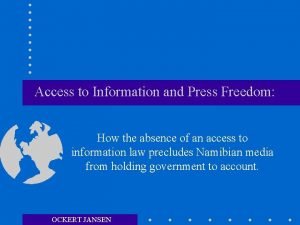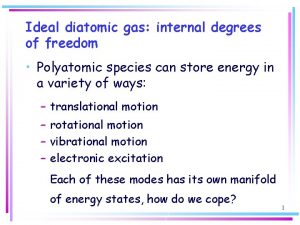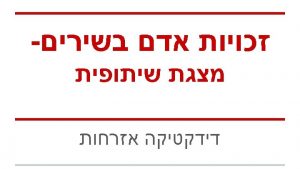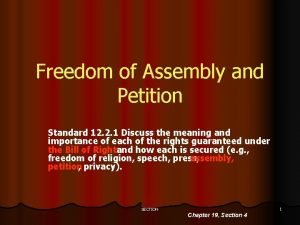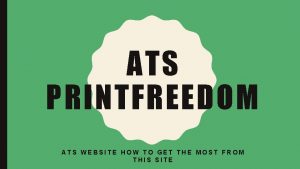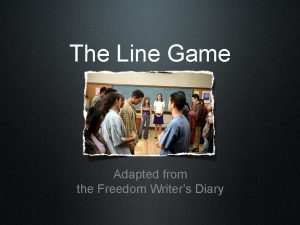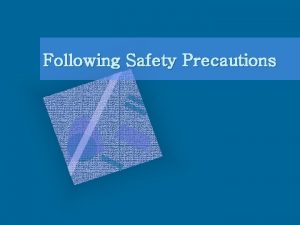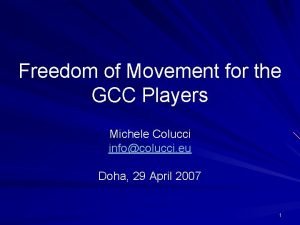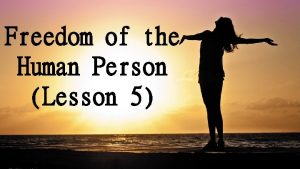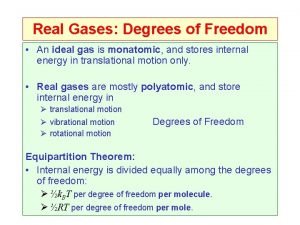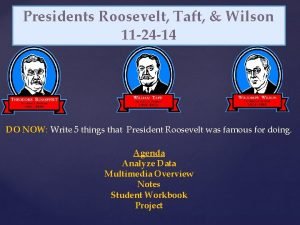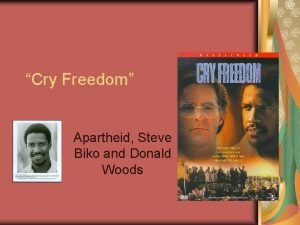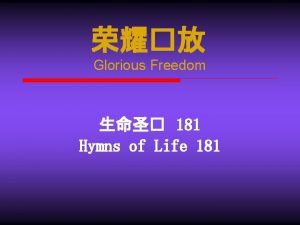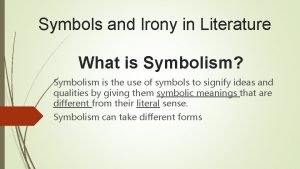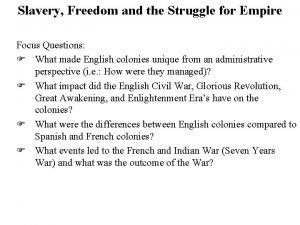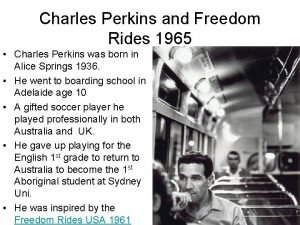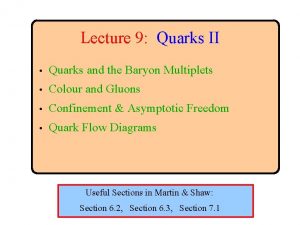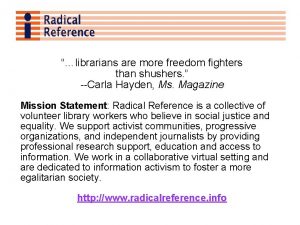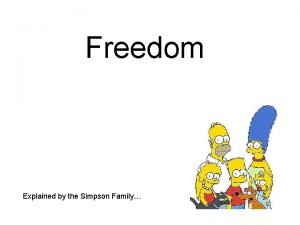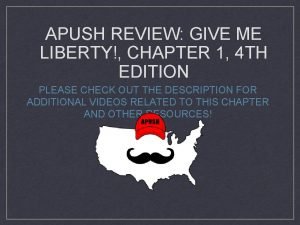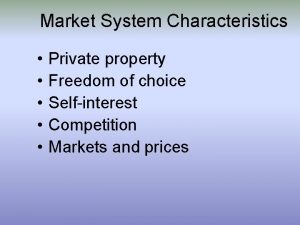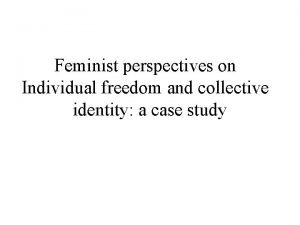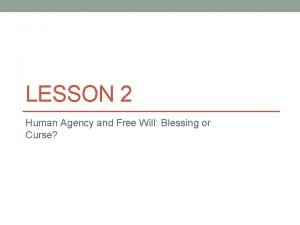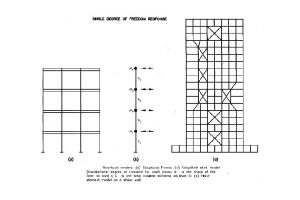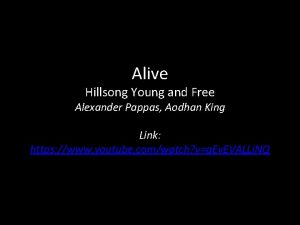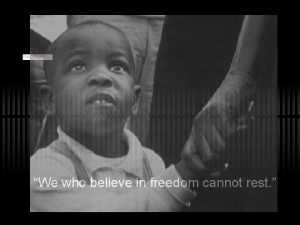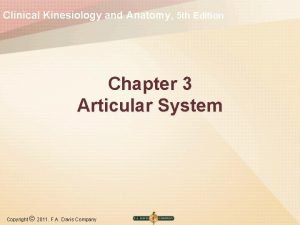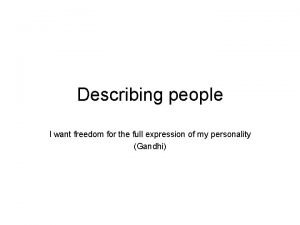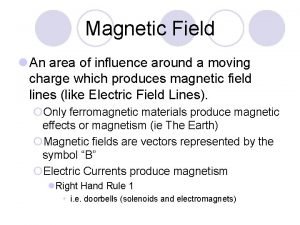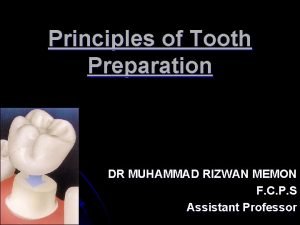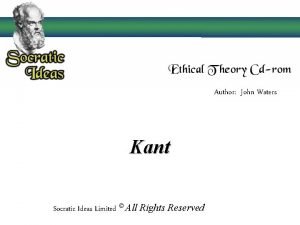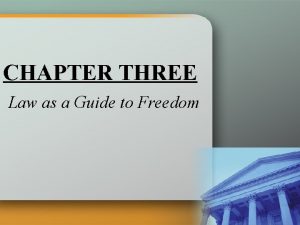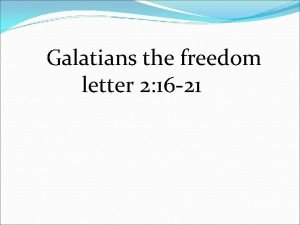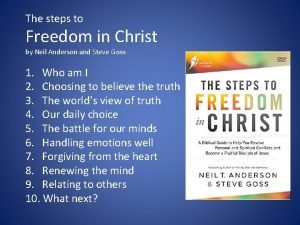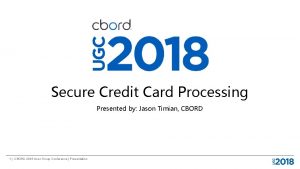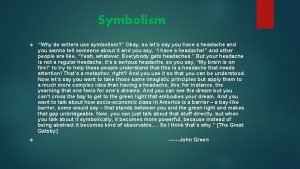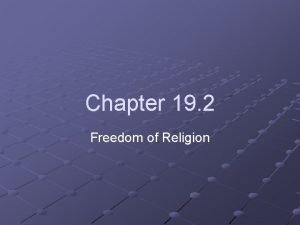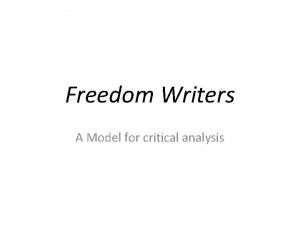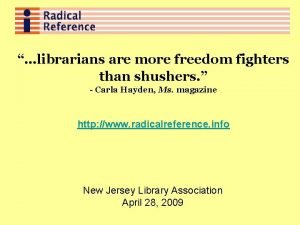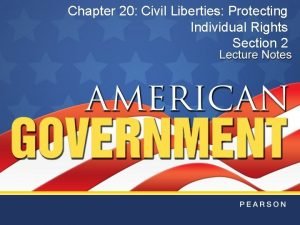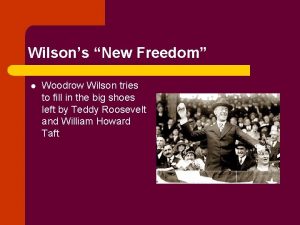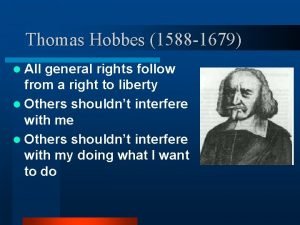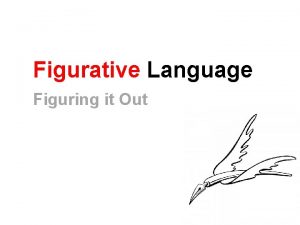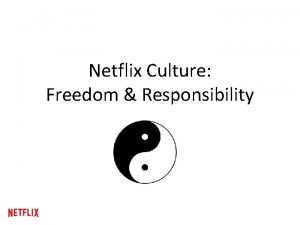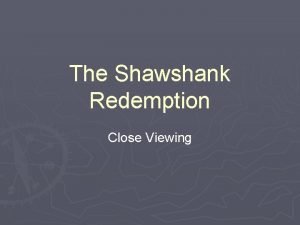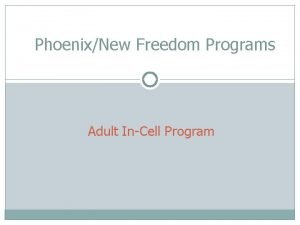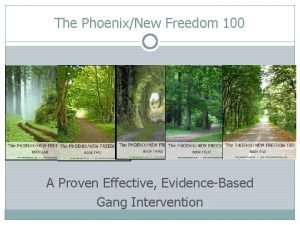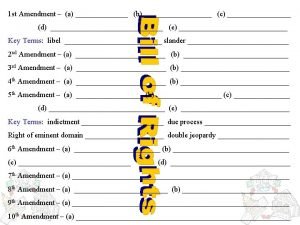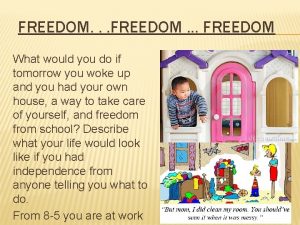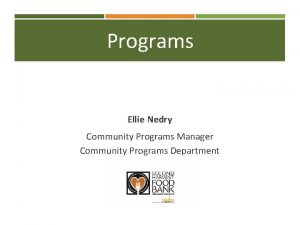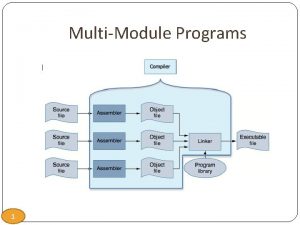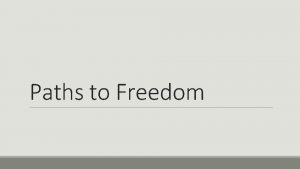PhoenixNew Freedom Programs PhoenixNew Freedom Programs v PhoenixNew








































































































- Slides: 104

Phoenix/New Freedom Programs

Phoenix/New Freedom Programs v Phoenix/New Freedom evidence-based resources are currently in use in more than 2500 programs in 50 states v Manualized and lesson-based change programming for a wide variety of environments, from adult corrections to community services to courts and community. v Change curricula in substance abuse, gang and violence, behavioral health, and more.

Phoenix/New Freedom Programs Some of our recent work: v A Functional Behavior curriculum in 23 prisons in California. v Major adseg step-down programs in Tennessee, Texas, and statewide in Georgia. v Three successful programs (one substance abuse and two mental health programs) in use at Rikers Island Jails in New York City v An extensive substance abuse program for youth housed by the NYDOCCS in 3 facilities

STEP-DOWN PROGRAM v Program provides structure for step down: alternatives to solitary housing. v Nine month lesson-based model, targeted to aggression, violence, and people problems (facility, unit, and cellmate). v Open group, open admission. Participants can enter or leave at any point once the pre-contemplation portion had been done v CBT-based, MI-infused resources for both in-cell and group work v Specific scenarios relating to life in the facility and the risks and triggers to violence

STEP-DOWN PROGRAM STRUCTURE: Ø Orientation (8 sessions) Ø Step 1: Self-Discovery (2 units, 10 sessions each) Ø Step 2: Conflict Resolution (6 units, 10 sessions each) Ø Step 3: Situational Confidence (3 units, 10 sessions each)

STEP-DOWN PROGRAM Each Unit has a specific set of goals: All resources in the unit are designed to help achieve these goals.

STEP-DOWN PROGRAM Each Unit offer 10 core sessions (45 mins to an hour). Each Unit follows a path Through the Stages Of Change Wherever a new person enters the group they will quickly encounter Pre-Contemplation resources they may need.

STEP-DOWN PROGRAM Each Unit includes a Lesson Plan. The Lesson Plans repeat the Unit goals to remind facilitators of what the lessons are designed to accomplish.

STEP-DOWN PROGRAM Lessons are made up of a variety of resources Workbooks: Already divided into 1 -hour chunks. Workbooks vary in length and focus on a single topic. For example: v SD 1 - Introduction to Self-Discovery v F 2 - Anger v GG 13 d- Disrespect v CS 9 - Stress Management v. Pre 12 - I can do this

STEP-DOWN PROGRAM Workbooks include their own lesson plans to guide the facilitator. Lesson plans include Behavioral Objectives and other helpful information for the facilitator

STEP-DOWN PROGRAM Lessons are made up of a variety of resources Worksheets and Turning Points: v Generally 1 hour or less v Often serve as summary activities in lesson 10 v Can be used to assess level of understanding and comprehension relative to the step-down decision

STEP-DOWN PROGRAM Lessons are made up of a variety of resources Discussion Scenarios: v Food For Thought- brief discussion starters useful for opening a group session and getting participants awake and talking v Choices and Changes (CC)- Somewhat longer resources focusing on choices and the change process

STEP-DOWN PROGRAM Lessons are made up of a variety of resources Discussion Scenarios: v Adjustment- brief scenarios about how to successfully do your time (Learning The Ropes, Nothing Is Free) v People Problems- dealing with other inmates in the system, including Bullying and Vicitmization

STEP-DOWN PROGRAM Lessons are made up of a variety of resources Discussion Scenarios: On The Unit- specific scenarios about typical problem situations that often lead to violence or conflict (Gambling, Contraband) v Cellmate Issues and Sharing a Cell- asking how to live with your cellmate without conflict (Trying to Sleep, The Messy Cellmate, Meds)

STEP-DOWN PROGRAM Lessons are made up of a variety of resources Discussion Scenarios: v Aggravation- asking how to handle without resorting to violence or fighting v A Practical Question- asking how to handle specific situations (Recruitment, Gang pressure, Loyalty)

STEP-DOWN PROGRAM Lessons are made up of a variety of resources Managing Aggression and Violence: Unit J is made up of anger management skills lessons from Managing Aggression and Violence series.

ORIENTATION UNIT v Critical first step– without chipping away at pre- or anti-contemplation the program will not work! v Orientation unit can be done in group or in-cell. You can create a small group for new arrivals, or have them do this unit in-cell. After that, new arrivals can join the group in progress wherever they are. v The primary goal is to engage participants, begin the process of selfawareness, and begin to challenge their pre-contemplative thinking

ORIENTATION UNIT

ORIENTATION UNIT v Introduces the programming and begins to chip away at precontemplation v Resources are clear– often used as self-study v A key goal of the Orientation will be to challenge pre-contemplative thinking v A secondary goal is to get participants comfortable disclosing and talking, a major driver of the program v Facilitators will need to use MI techniques to draw out participants and to challenge their pre-contemplative position.

ORIENTATION UNIT– A Closer Look PRE 6: Introduction to the Program

ORIENTATION UNIT– A Closer Look PRE 6: Introduction to the Program

ORIENTATION UNIT– A Closer Look SD 1: Introduction to Self-Discovery

ORIENTATION UNIT– A Closer Look SD 1: Introduction to Self-Discovery

ORIENTATION UNIT– A Closer Look Pre 11: You can’t change me

ORIENTATION UNIT– A Closer Look

ORIENTATION UNIT– A Closer Look This ending worksheet can be used to qualify readiness to proceed to Unit A.

ORIENTATION UNIT– A Closer Look The answers to these questions can really give you an idea of their current readiness to proceed to Unit A.

ORIENTATION UNIT– A Closer Look v Can be used for participants who are lagging behind the group in terms of pre-contemplation, or for the whole group v Can be done in-cell as homework, then processed one-on-one v Can extend the Orientation Unit and be processed in group

ORIENTATION UNIT– A Closer Look SD 7 a: My Life Story NOTE: This sort of self-disclosure could bring up buried trauma in participants.

ORIENTATION UNIT SD 7 a: My Life Story

ORIENTATION UNIT– A Closer Look SD 2: What Went Wrong

UNIT A: INTRODUCTION TO GROUP v Mostly workbook based v Primarily focused on Pre-Contemplation v Good MI skills would be especially useful with this unit!

UNIT A: INTRODUCTION TO GROUP

UNIT A: INTRODUCTION TO GROUP

UNIT A: INTRODUCTION TO GROUP v Participants should be encouraged to have a free discussion. v You can put the cards in a hat, have individuals draw from the hat and respond, then ask the other participants what they would have said. v You can also have participants answer on paper, then ask them to share their answers with the group. v The goal is to clarify values and self-understanding!

UNIT A: INTRODUCTION TO GROUP Worksheet– Where Do You Stand

UNIT A: INTRODUCTION TO GROUP

UNIT A: INTRODUCTION TO GROUP ICD-What’s Treatment All About includes a decisionalbalancing tool in addition to ICR rulers.

UNIT A: INTRODUCTION TO GROUP Worksheet– Prior Program Experiences

UNIT A: INTRODUCTION TO GROUP CC 1 - What’s Been Getting You In Trouble? asks participants to begin to identify their own personal risk factors for a variety of things.

UNIT A: INTRODUCTION TO GROUP

UNIT A: INTRODUCTION TO GROUP Lesson 10 of Unit A contains two critical resources:

UNIT A: INTRODUCTION TO GROUP Pre 4 - How Important Is It To You?

UNIT A: INTRODUCTION TO GROUP Pre 4 - How Important Is It To You?

UNIT A: INTRODUCTION TO GROUP Worksheet: Program Assessment (motivation)

UNIT B: HANDLING PEOPLE PROBLEMS HERE SUCCESSFULLY v A few more worksheets that Unit A v Largely made up of discussion scenarios v The resources guide the discussion in a way that helps participants think through their choices

UNIT B: HANDLING PEOPLE PROBLEMS HERE SUCCESSFULLY The first two lessons feature some critical worksheets: What Happened To You 4 -8 What Happened To You 9 -12 These worksheets help participants explore things that happened to them in their past. It presents the concept that who we are today is based, in part, on both good and bad things that happened to us in our past and that we become who we are through things we have learned and didn’t learn.

UNIT B: HANDLING PEOPLE PROBLEMS HERE SUCCESSFULLY The first two lessons feature some critical worksheets: What Happened To You 4 -8 What Happened To You 9 -12 These worksheets help participants explore things that happened to them in their past. It presents the concept that who we are today is based, in part, on both good and bad things that happened to us in our past and that we become who we are through things we have learned and didn’t learn.

UNIT B: HANDLING PEOPLE PROBLEMS HERE SUCCESSFULLY Worksheet - What was going on -Trouble This workbook asks participants to look back at things that happened as a way to learn more about themselves. The past tends to repeat itself. This worksheet establishes that we don’t have to repeat the old mistakes, and we can also build on the good decisions we made. NOTE: These worksheets have been edited for you to lessen the impact, but nevertheless, they could bring up trauma. Less-experienced facilitators may not be equipped to handle it.

UNIT B: HANDLING PEOPLE PROBLEMS HERE SUCCESSFULLY Lessons that are made up of discussion scenarios usually feature the same Lesson Plan:

UNIT B: HANDLING PEOPLE PROBLEMS HERE SUCCESSFULLY The final lesson features two summarizing resources:

UNIT C: FIGHTING AND VIOLENCE #1 v Several key worksheets v Largely made up of discussion scenarios v A couple of workbooks

UNIT C: FIGHTING AND VIOLENCE #1 The first lesson features two key workbooks: Worksheet - Fighting and Violence helps participants understand their own attitudes and thoughts about violence. It includes Confidence and Importance rulers to help assess their motivation to change.

UNIT C: FIGHTING AND VIOLENCE #1 Worksheet Experiences with Violence helps participants explore their own histories of violence, then connects those experiences with the violent behavior they have exhibited as adults

UNIT C: FIGHTING AND VIOLENCE #1 Worksheet Experiences with Violence also includes a key Decisional Balancing tool.

UNIT C: FIGHTING AND VIOLENCE #1 ü It is important that facilitators take the time they need to make sure both of these resources are processed fully! ü If the facilitator needs to skip the short element to do so, that’s fine.

UNIT C: FIGHTING AND VIOLENCE #1 This unit includes a key workbook from our Gang series: GG 13 d: Dealing With Disrespect The purpose of this workbook is to assist participants in dealing with a common problem situation -- dealing effectively with perceived disrespect. It is a key step in handling problems to reduce the risk of violence.

UNIT C: FIGHTING AND VIOLENCE #1 This workbook provides for role playing, based on scenarios provided by cards, to help participants become proficient at recognizing the triggers for being disrespected.

UNIT C: FIGHTING AND VIOLENCE #1 One suggestion is to put the participants in pairs, and let one be the disrepecter and the other the person who will use the skill. The participants may be asked to describe the use of the steps in this skill to deal with the situation. The facilitators and other class members can evaluate the learner’s response to the given situation.

QUALIFIER OPTIONS Unit C is the end of Step 1. We have provided two resources that could be used to help qualify participants’ readiness to proceed to the next step: CF 8: Adding to your Troubles Confidence assessment CF 9: Adding to your Troubles Importance checklist

QUALIFIER OPTIONS Unit C is the end of Step 1. We have provided two resources that could be used to help qualify participants’ readiness to proceed to the next step: CF 8: Adding to your Troubles Importance Checklist CF 9: Adding to your Troubles Confidence Assessment

QUALIFIER OPTIONS CF 8: Adding to your Troubles Importance Checklist The resource presents a list of common issues and problems, and asks the participant to rate their importance to him.

QUALIFIER OPTIONS CF 9: Adding to Your Troubles Confidence Assessment The resource asks the participant to rate their confidence that they can handle the same list of common issues and problems.

QUALIFIER OPTIONS These two resources will appear at the end of Steps 2 and 3– exactly the same resource. The idea is that you should see positive movement in their responses to these resources at the end of each step. If you do not see movement, it is another clue that the individual is not really getting it, and may need to repeat a step.

UNIT D: HANDLING PEOPLE PROBLEMS HERE SUCCESSFULLY #2 v Largely made up of discussion scenarios v A few more Turning Point resources v The resources guide the discussion in a way that helps participants think through their choices

UNIT D: HANDLING PEOPLE PROBLEMS HERE SUCCESSFULLY #2 TP 2 Then And Now asks participants to examine past experiences to clarify what went : 1. Identify specific negative risk factors (people, places things, and situations) which contributed to past. 2. Identify specific protective factors which were present in their past. 3. Identify new external resources they will develop to support recovery and positive lifestyle changes. 4. Describe steps they will take to reconnect and build relationships with past protective factors. 5. Identify specific obstacles or barriers which stand in the way of making positive changes and steps they will take to overcome them.

UNIT D: HANDLING PEOPLE PROBLEMS HERE SUCCESSFULLY #2 TP 16 I Can Do This asks participants to identify key areas of personal strength that they can draw on to face the challenges of making positive changes in their lives. Using a tool provided, they will assess their degree of personal resilience, and specific areas of positive self-worth.

UNIT E: ANGER v Largely made up of workbooks v Includes one discussion starter to open each session v Explores several aspects of Anger, including what anger does to us.

UNIT E: ANGER F 10 explores the role of feelings in relapse, whether drug and alcoholrelated relapse or other types of recidivism. It focuses on uncomfortable feelings, and asks participants to: • summarize current understanding of their own uncomfortable feelings • describe current frequency, intensity and duration of specific uncomfortable feelings • describe anticipated future problem situations, and steps he/she will take to handle them

UNIT E: ANGER

UNIT E: ANGER F 2 Anger provides an increased understanding of angry feelings, including: • anger issues and triggers • repressed anger • passive-aggressive behavior • the link between anger and dependencies

UNIT E: ANGER Participants will describe and identify: • anger in specific situations • most frequent symptoms that they are angry • most powerful or frequent triggers for anger • unresolved anger issues • issues of anger and relationships • current emotional status • a personal action plan for dealing with anger

UNIT E: ANGER F 13 What Does Anger Do To You explores anger symptoms through a series of illustrative scenarios, a list of physical, emotional, and behavioral symptoms, and some key tools, including: ● Anger Symptoms Scale ● Frequency, Intensity, and Duration tool ● a Decisional Balancing tool It will be important that facilitators know how to use these tools!

UNIT E: ANGER

UNIT E: ANGER

UNIT F: FIGHTING AND VIOLENCE #2 v Largely made up of workbooks and worksheets v Includes one discussion starter to open each session v Includes the Importance Checklist and Confidence Assessment resources to assist a spot check on participant’s progress

UNIT F: FIGHTING AND VIOLENCE #2 Worksheet What Happened In Your Life explores the risk factors faced in childhood that impacted the way their lives have gone. Some of this material may be similar to other resources in the program. This is deliberate– this worksheet puts their exploration of the risk factors they faced in the past in a slightly different context. This understanding of how they got here is critical to ensuring they make the changes they need so that they don’t come back! Facilitators may need to know how to deal with participants who complain that they’ve done some of this already.

UNIT F: FIGHTING AND VIOLENCE #2 Worksheet Growing Up Around Violence explores how the violence we experience in childhood affects the individual. In particular it is imperative that the facilitator carefully review the objectives for this unit, and steer the conversations this worksheet generates towards those objectives.

UNIT F: FIGHTING AND VIOLENCE #2 GG 13 r Respect addresses the respect they give others, as well as ways to gain respect from others. Topics addressed include: • real respect versus fear • respect they give other people • identifying people worthy of respect • self-assessment on the characteristics of being worthy of respect

UNIT G: YOUR MINDSET AND YOUR CHOICES v Largely made up of workbooks from our gang series v Includes one Turning Point resource v Explores the gang mindset as well as the concept of loyalty

UNIT G: YOUR MINDSET AND YOUR CHOICES GG 1 What Was On Your Mind uses a cognitive restructuring approach to gang activity: v It identifies selected negative mindsets common to people involved in gang activity. v Then it addresses each one, identifying weaknesses in that form of thinking and offering guidance in the development of a more positive outlook. v One goal is to develop alternative, positive mindsets.

UNIT G: YOUR MINDSET AND YOUR CHOICES

UNIT G: YOUR MINDSET AND YOUR CHOICES NOTE: In considering their mindsets– and the potential violence they led to in their lives, this lesson could bring up trauma. Less-experienced facilitators may not be equipped to handle it.

UNIT G: YOUR MINDSET AND YOUR CHOICES GG 13 Loyalty looks at a key enabler of violence and gang activity, misplaced ideas of loyalty. With a practical focus it assists them in developing excuses for avoiding activities they may be pressured to join. A series of role playing cards gives them the opportunity to practice using the excuses they develop.

UNIT G: YOUR MINDSET AND YOUR CHOICES

UNIT G: YOUR MINDSET AND YOUR CHOICES GG 7 Understanding Yourself provides the opportunity for participants to identify their triggers and highest risk factors for violence and to develop strategies to avoid these issues or to cope more effectively in the future. v Identify “set-ups” and risk factors for violence in their lives. v Identify specific violence triggers. v Identify specific options that can use to avoid and/or deal with critical risk factors (gang activity, high risk people, places, things, and situations—as well as family disputes). v Identify past situations where they actually planned to do violence. v Develop an action plan to address past triggers to violence. v Develop an action plan for new activities which can serve as alternatives to old violence-based activities

UNIT G: YOUR MINDSET AND YOUR CHOICES TP 7 RH 30 I Can't Ever Do That Again asks participants to consider drawing a line-- what they will not do again. This turning point is critical to creating a new life and avoiding the types of troubles that brought them here. It is the culminating lesson to address the objectives of this lesson.

UNIT H: HANDLING THE TOUGH TIMES v Content is primarily from our Handling The Tough Times series v There are no separate lesson plans for this Unit– lesson plans are included in the TT resources. v These are skills-based lessons, and thus do not follow the Stages Of Change

UNIT H: HANDLING THE TOUGH TIMES v Lesson plans are complete v Since these are skills, some preparation notes are included

UNIT H: HANDLING THE TOUGH TIMES Lesson plans are partially scripted, modeling what to say This unit is ideal for less-experienced facilitators!

UNIT H: HANDLING THE TOUGH TIMES TP 3 The New Reinvented You is the final lesson. It provides the opportunity to explore giving oneself a fresh start. It helps participants: v clarify new goals v assess their strengths and assets v summarize their support system v clarify their commitment to change

UNIT I: HANDLING PEOPLE PROBLEMS HERE SUCCESSFULLY #3 v Largely made up of discussion scenarios, like the previous People Problems units v A few more Turning Point resources and a worksheet

UNIT I: HANDLING PEOPLE PROBLEMS HERE SUCCESSFULLY #3 v This Unit marks the end of Step 2. v It concludes with the Importance Checklist and Confidence Assessment. v There should be movement along these scales from the previous times participants have worked these resources. v As before, participants may complain about having done this before. It will help less experienced facilitators to strategize effective responses.

UNIT J: MANAGING AGGRESSION AND VIOLENCE v Skills-based lessons for managing violence and aggression v A few more Turning Point resources and a worksheet

UNIT J: MANAGING AGGRESSION AND VIOLENCE Each lesson presents a different useful skill. Skills are often summarized step by step. Participants can take these with them if that is permissible.

UNIT J: MANAGING AGGRESSION AND VIOLENCE Lesson include role play cards for use in practicing the skill.

UNIT J: MANAGING AGGRESSION AND VIOLENCE The final lesson includes a key symptoms management lesson– tracking the Frequency, Intensity, and Duration of anger. This gives participants keen insight into the cycles and sources of their anger.

UNIT K: STRESS MANAGEMENT v Skills-based lessons for managing stress v Each lesson includes a discussion starter. v The content is primarily two workbooks

UNIT K: STRESS MANAGEMENT GG 4 Living A Non-Violent Life provides the opportunity for clients to identify their triggers and highest personal risk factors for violence. It will help them develop strategies to avoid these issues or to cope more effectively in the future. The workbook helps them: v evaluate the impact of 15 specific risk factors for violence in their lives v identify specific action steps they will take to reduce the impact of each risk factor v identify the “payoff” for violence in their life

UNIT K: STRESS MANAGEMENT v identify specific action steps to achieve the same types of “payoffs” without using violence. v evaluate the role of additional risk factors for violence in their life (guns, alcohol and other drugs, bystanders, being a “wannabee, ” living a “double life, ” etc. ).

UNIT K: STRESS MANAGEMENT CS 9 Stress Management-- A basic stress management workbook, including: ü ü ü self-examination symptoms awareness identification of triggers underlying stressors and lifestyle issues evaluation of past coping introduction to several key coping skills If a skill is presented in the lesson, facilitators will need to leave ample time to practice the skill.

UNIT K: STRESS MANAGEMENT The Unit concludes with TP 15 - The Future It presents one example (Ritchie) who is about to be released. Participants examine an assortment of issues that Ritchie will be facing upon his return to the community and asks participants to evaluate his chances for success.

UNIT L: CELLMATE ISSUES v Completely scenario-based v Includes materials on asking for help and addressing problems with authority

UNIT L: CELLMATE ISSUES v This is the concluding Unit of Step 3. v Includes the final application of the Importance Checklist and Confidence Assessment Participants at this stage should be well into Contemplation, with some in the early Preparation/Determination stage
 Positive freedom negative freedom
Positive freedom negative freedom Glorious freedom wonderful freedom
Glorious freedom wonderful freedom Disadvantages of waterfall model in software engineering
Disadvantages of waterfall model in software engineering Freedom
Freedom Qvib
Qvib Little sussie
Little sussie Physically perfect violence is a modifier of human act
Physically perfect violence is a modifier of human act Chapter 19 section 4 freedom of assembly and petition
Chapter 19 section 4 freedom of assembly and petition Ats print freedom
Ats print freedom Freedom worklist
Freedom worklist Line game questions
Line game questions Freedom from danger risk or injury
Freedom from danger risk or injury Operation iraqi freedom map
Operation iraqi freedom map Slovakia my homeland
Slovakia my homeland Nc first in freedom
Nc first in freedom Freedom writers quiz
Freedom writers quiz Principles of tooth prep
Principles of tooth prep Freedom writers conclusion
Freedom writers conclusion What animal represent freedom
What animal represent freedom Gcc freedom of movement
Gcc freedom of movement Pediatric hospitalist near freedom
Pediatric hospitalist near freedom Shell cleanliness shell soundness shell texture shell shape
Shell cleanliness shell soundness shell texture shell shape Lex naturalis kahulugan tagalog
Lex naturalis kahulugan tagalog Freedom seekers mc
Freedom seekers mc Freedom of the hills
Freedom of the hills Degree of freedom of an ideal gas
Degree of freedom of an ideal gas Robert holbrook smith
Robert holbrook smith New nationalism vs new freedom venn diagram
New nationalism vs new freedom venn diagram Donald woods cry freedom
Donald woods cry freedom Glorious freedom hymn
Glorious freedom hymn Which statement best summarizes chapter 11
Which statement best summarizes chapter 11 Freedom combi inverter charger
Freedom combi inverter charger Understatement in literature
Understatement in literature Slavery freedom and the struggle for empire
Slavery freedom and the struggle for empire Speech success criteria
Speech success criteria True sons of freedom
True sons of freedom Charles perkins
Charles perkins Geometry acrostic poem
Geometry acrostic poem Total debt freedom
Total debt freedom Asymptotic freedom
Asymptotic freedom What is a freedom
What is a freedom Fuel freedom international
Fuel freedom international Freadom fighters librarians
Freadom fighters librarians Map of harlem new york
Map of harlem new york Freedom letter
Freedom letter Family tension freedom duty
Family tension freedom duty Liberty or freedom
Liberty or freedom Freedom and responsibility speech
Freedom and responsibility speech Private property characteristics
Private property characteristics Conclusion of freedom
Conclusion of freedom Liberty or freedom
Liberty or freedom Sifive core designer
Sifive core designer Damped free vibration
Damped free vibration Hillsong young & free aodhan king
Hillsong young & free aodhan king We who believe in freedom cannot rest
We who believe in freedom cannot rest Degrees of freedom kinesiology
Degrees of freedom kinesiology I want freedom for the full expression of my personality
I want freedom for the full expression of my personality Dr arnason
Dr arnason Freedom of press definition
Freedom of press definition Kron the alien freedom fighter
Kron the alien freedom fighter Muslim freedom fighters name
Muslim freedom fighters name Overinclination
Overinclination Kant
Kant Freedom vs love
Freedom vs love Philosophy freedom and responsibility
Philosophy freedom and responsibility Freedom letter
Freedom letter Steps to freedom in christ
Steps to freedom in christ Emotional freedom technique
Emotional freedom technique Stress portrait of a killer summary
Stress portrait of a killer summary Freedom pay credit card processing
Freedom pay credit card processing Freedom arc
Freedom arc Why do writers use symbols
Why do writers use symbols Chapter 19 section 2 freedom of religion
Chapter 19 section 2 freedom of religion One sample z interval formula
One sample z interval formula Scotch yoke mechanism
Scotch yoke mechanism Flex your freedom
Flex your freedom What is academic freedom
What is academic freedom Erin gruwell freedom writers: stories from the heart
Erin gruwell freedom writers: stories from the heart Freadom fighters librarians
Freadom fighters librarians Freedom of association
Freedom of association Freedom writers journal entries
Freedom writers journal entries Phase diagram
Phase diagram Chapter 20 section 2 freedom and security of the person
Chapter 20 section 2 freedom and security of the person Woodrow wilsons new freedom
Woodrow wilsons new freedom Freedom photonics
Freedom photonics Were gonna dance
Were gonna dance Freedom trial
Freedom trial John boswick
John boswick Emerald director usana salary
Emerald director usana salary Sixth freedom traffic
Sixth freedom traffic Thomas hobbes liberty
Thomas hobbes liberty Areas table
Areas table Love hyperbole examples
Love hyperbole examples Write a short note on negative liberty
Write a short note on negative liberty The protocol ensures freedom from deadlock.
The protocol ensures freedom from deadlock. Statue of liberty symbols
Statue of liberty symbols Define intellectual freedom
Define intellectual freedom George gordon lord byron
George gordon lord byron Highly aligned loosely coupled
Highly aligned loosely coupled Diamante poem winter
Diamante poem winter Holt call to freedom
Holt call to freedom For our freedom and yours
For our freedom and yours Freedom club usa.com
Freedom club usa.com Tommy shawshank redemption
Tommy shawshank redemption Rachel lippert
Rachel lippert



